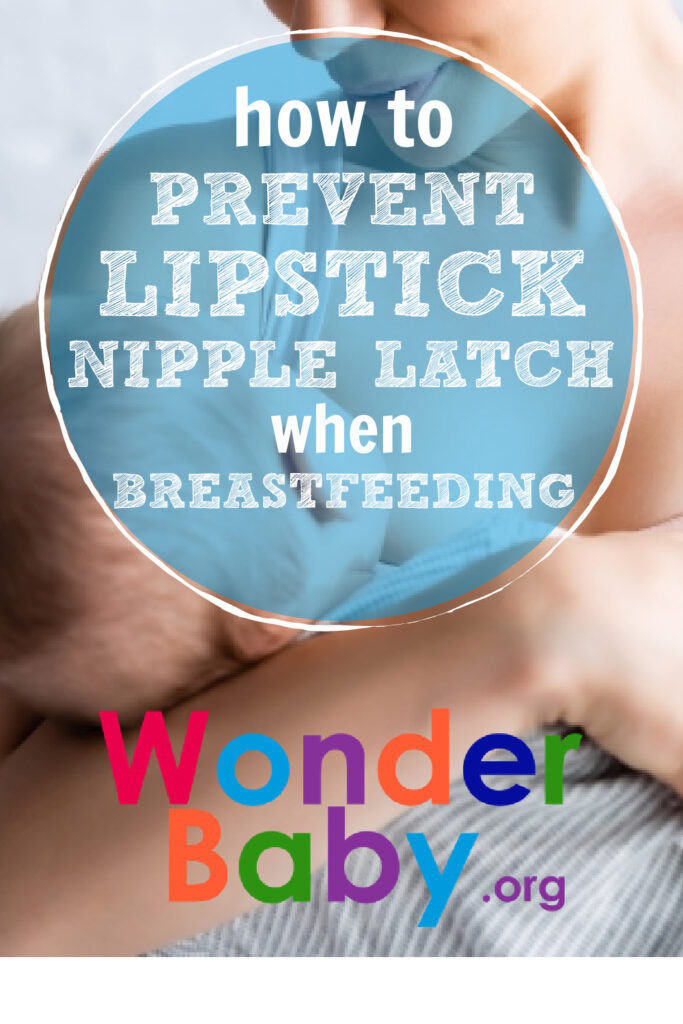How to Prevent Lipstick Nipple Latch When Breastfeeding

- Lipstick nipple refers to a condition where the nipple temporarily appears slanted and misshapen. This is caused by breastfeeding with a shallow latch.
- The easiest way to correct lipstick nipple is with breastfeeding techniques that ensure a proper latch.
- The primary indicator of a bad latch is pain and discomfort while breastfeeding.
- The second indicator of a shallow latch is if your baby is fussy, frustrated, or hungry after feeding.
- It’s possible to have lipstick nipple AND a good latch. As long as the baby is getting enough milk and the mother isn’t in pain, there’s no issue.
Breastfeeding is often challenging in the beginning. Even if you’re doing everything correctly, you’ll likely experience sore nipples, cracking, and some struggles with your baby getting a deep latch every time. And knowing how to identify when your baby is latching correctly and when they do not take time.
One common side effect of an improper latch is something known as lipstick nipple, and it can be painful and unsettling. Fortunately, there are some steps you can take to prevent this from happening.
What is Lipstick Nipple?
Lipstick nipple happens when the nipple temporarily changes shape due to nursing with misplaced pressure from a poor latch. The nipple looks similar to the tapered tip of a new lipstick tube, hence the name.
Why Does Lipstick Nipple Latch Happen?
Lipstick nipple is often caused by a shallow latch. It’s a common occurrence, and sometimes it’s not a problem. However, if it’s causing discomfort or insufficient milk supply, you will need to take steps to remedy it.
The most important thing is that your baby is getting a deep latch, which is most comfortable for you and the baby and ensures proper milk flow. The following techniques will help you secure a deeper latch and prevent lipstick-shaped nipples.

How Can I Fix Lipstick Nipple Latch?
The following steps will not only correct lipstick nipple but ensure that your baby gets a good latch every time.
- First, rule out any possible medical issues.
You want to make sure that your baby can breastfeed, meaning they do not have a tongue tie or lip tie, and that any pain you’re experiencing is not due to thrush or bacterial infection.
A tongue tie is when the strip of skin connecting the bottom of your baby’s tongue to their mouth is shorter than usual. Lip ties are similar to this and often happen concurrently with tongue ties. This issue can make it difficult for babies to get a good latch.
Make sure your pediatrician checks your infant for a lip or tongue tie at the hospital and in early postnatal appointments.
If you develop lipstick nipple or repeatedly struggle to get a good latch, consult your pediatrician and ask them to check for it again. A pediatric dentist can usually correct any lip or tongue issues with a minimally invasive procedure when the baby is young.
- Create a quiet, calm space to breastfeed.
Once you’ve determined that your baby is physically able to breastfeed, create a calming soothing space for it. Feeding your baby in a space that is quiet, calm, and free from distractions is not only good for them but will also help you to feel relaxed and less stressed.
Start with skin-to-skin contact. Undress yourself and your baby, at least from the waist up, and rest them on your bare chest. This helps them to bond and connect. Often your baby will naturally start to root around looking for the breast.
For information on breastfeeding a visually impaired infant, consult your pediatrician or lactation consultant for extra guidance.
- Let your baby lead.
Supporting your baby’s head, offer your breast and let your baby find the nipple on their own. Allowing the baby’s latch to happen organically can often provide the best connection.
- Open your baby’s mouth wide.
Once your baby knows the breast is there, most will naturally open their mouths wide, but sometimes you will need to assist them with this. Rub your nipple across the baby’s top lip, and as your baby opens their mouth gently pull on their chin to open wide. Aim to get your nipple past your baby’s gums to ensure a deep latch and comfortable feeding experience.
A proper latch happens when your baby’s mouth encompasses the nipple and areola, and their lips will curl outward (like a fish) as they eat. If your baby’s lips are secured tightly around the base of the nipple, they have a shallow latch. You will need to unlatch and try it again.
- Unlatch and start over.
If you feel discomfort, that’s your primary indicator of a poor latch. Additionally, if your baby seems frustrated and cranky, that’s a good indicator that they aren’t getting much breast milk. In this case, it’s best to unlatch and try again.
Break the suction by placing a finger along the side of the nipple and into your baby’s mouth. Unlatching can make babies fussy, but it’s much better to re-latch and have a proper pain-free breastfeeding experience.
- Point your nipple up.
With your baby’s mouth open, aim your nipple upwards towards the roof of their mouth. This will help you bypass their gums and get more areola and breast tissue into their mouth, ensuring your baby latches correctly.
- Place your baby’s chin against your breast.
A laid-back breastfeeding position will place your baby close to your body with their chin slightly tilted upwards. Positioning your baby’s chin against your breast allows them to get as much breast tissue as possible.
At first, this can be concerning for new mothers as this often causes the baby’s nose to press up against the breast too. Rest assured, babies can breathe around the sides of their noses, and most babies will naturally unlatch if they’re struggling to get enough air.
- Focus on your baby’s lower lip.
Making sure your baby’s lower lip is the first to contact the breast is a great way to avoid the misplaced pressure that causes a lipstick-shaped nipple. Align the bottom lip with the edge of your areola, far from the base of the nipple. Then bring the rest of their mouth upwards and onto the breast.
- Compress your breast.
Cupping your hands into a “U” shape and squeezing your breast before presenting it to your baby could help them to get more of your nipple and areola into their mouth.
- Try different feeding positions.
You can often get a better latch by trying different breastfeeding positions. Reclining to feed, the cradle hold, the cross-cradle hold, a football hold, or lying on your side are all helpful positions for newborns.
All breastfeeding positions should support your baby’s body and keep their shoulders, back, and neck aligned.
- Get a nursing pillow.
I used my nursing pillow every day and highly recommend them to breastfeeding mothers. These pillows are great for supporting your baby’s alignment and comfort and for placing them closer to the breast.
Additionally, they’re excellent for alleviating strain on the mother’s back and providing support. These pillows are also incredibly useful for a number of other non-breastfeeding activities as well.
- Try using a nipple shield.
Nipple shields are intended for mothers experiencing serious latch issues and are for temporary use under the guidance of a lactation professional. Some common situations where breastfeeding may be improved by the use of a nipple shield include: 1) women with flat or inverted nipples, and 2) when breastfeeding premature babies who may not be strong enough to create enough suction on their own.
If your baby is continuously having issues with latching and you’re chronically experiencing lipstick nipple, you should consult with your doctor or lactation specialist to determine if a nipple shield may be right for you. These shields can protect the nipple and prevent the lipstick shape while giving your baby access to the extended tip of the nipple shield.

How Do I Know if I Have a Good Nursing Latch?
The simplest way to tell if your baby is latching well is if breastfeeding is comfortable and pain-free. You can also tell your baby has a good latch if:
- Your baby’s body is in good alignment. When feeding, your baby’s head should never be turned to the side or crooked at the neck.
- Your baby’s chin touches the breast, with lips relaxed and turned out.
- Your baby’s mouth takes in a lot of the areola and breast tissue, not just the nipple.
- You hear and see your baby swallowing.
- Your baby’s ears move slightly when feeding.
Can I Have Lipstick Nipple and a Good Latch?
Yes, sometimes. There are instances where you may notice a lipstick nipple appearance after feeding, but it recedes in a typical amount of time. If you’re not in discomfort and your baby is eating, there’s no cause for concern. The primary indicator of a poor latch is pain and a frustrated fussy baby.
How Does Nursing Affect Nipples?
Pregnancy affects your breasts and nipples in many ways—whether you choose to breastfeed or not. You may find your nipples get larger, are different sizes, softer, or more pronounced.
Areolas tend to get larger and darken considerably, and bumps known as Montgomery’s tubercles might appear and get bigger. All of this happens as your body’s way of adapting to and preparing to feed your baby.
Even when you’re breastfeeding correctly, you’re likely to experience sensitivity, pain, blistering, cracking, or bleeding nipples in the first few days. Most women reported their nipple sensitivity peaking at day five and receding after that.
A few things that might help with nipple pain:
- Good ol’ breastmilk—rubbed around the nipple and areola after each feeding.
- Coconut oil or olive oil. Newer ointments on the market are usually based on these oils and have little smell or taste to interfere with your baby’s senses.
- Hydrogel pads create a soothing barrier to relieve sore nipples and prevent rubbing.
- Calendula-based creams.
- Avoid lanolin-derived ointments (often used in the past) as they are prone to causing allergic reactions. They also have a strong smell and flavor, which can cause your baby to refuse to breastfeed.
FAQs
What else can a bad latch nipple look like?
Symptoms of a bad latch include:
- The nipple looks slanted (like a tube of lipstick) or has a white line across it. Your nipple should be round after breastfeeding.
- You can see your baby sucking in their cheeks as they try to feed.
- Hearing clicking or smacking noises like the baby is taking in air as they try to get suction.
- Your baby’s lips look tucked in or under. They should curl out like a fish’s.
- If your nipples are sore, the pain isn’t getting better, or your milk supply is low.
- Your baby seems unhappy, frustrated, or still hungry after feeding.
- A newborn that’s losing weight or struggling to gain weight at an optimal rate.
- Your baby frequently unlatches during a feeding.
- Your baby is not gaining weight or is losing weight.
Does nipple shape affect breastfeeding?
The size and shape of your nipples rarely affect your ability to breastfeed. Most babies can breastfeed regardless of what their mother’s nipples are shaped like.
Flat or inverted nipples can sometimes make it more difficult to get a deep latch. However, remember that your baby must latch on to the nipple and the areola in order to breastfeed. This means that even flat, inverted nipples work well, and often the nipples protrude more over time as you continue to breastfeed.

The information WonderBaby provides is not intended to be, and does not constitute, medical or other health advice or diagnosis and should not be used as such. Always consult with a qualified medical professional about your specific circumstances.
Related Posts

Breastfeeding, Sleep
Sleep and Breastfeeding: A Comprehensive Guide for Nursing Moms
Many people assume breastfeeding and sleep training don’t go together, but it is possible to help your baby sleep better while continuing your breastfeeding journey.

Breastfeeding
Comfort Nursing: Pros, Cons, and How to Stop
Find out what comfort nursing is, when should you worry about it, and how to stop or limit your baby's comfort nursing (especially at night!).

Breastfeeding, Product Reviews
5 Best Breastfeeding Chairs for Nursing Moms of 2023
Whether you want a gentle rock, a smooth glide, or a cozy cuddle to soothe your baby to sleep, you’ll have your pick of the best breastfeeding chairs on the...